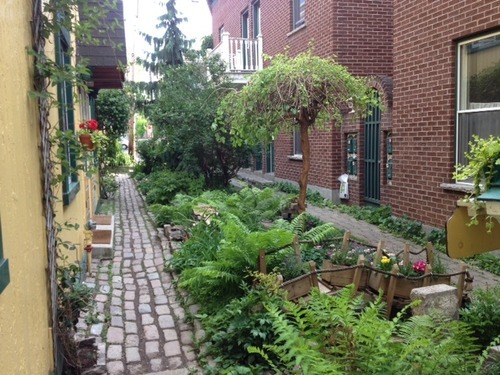Placemaking: The Reimagined Laneway
The ubiquitous city laneway is experiencing an urban renaissance. Instead of being the historic home to dumpsters, garbage trucks, graffiti, rats and alleycats, cities around the world are reimagining laneways as street markets, art installations, performance spaces and nature retreats.
Last week I wrote about Vancouver's Country Lane pilot project, which involved transforming several residential back alleys into grassy, picturesque country lanes. This week, I decided to look at some successful examples of transformed urban laneways around the world. Here is a snapshot:
City of Sydney's Forgotten Songs:Completed in 2011 by Michael Thomas Hill, this installation commemorates the songs of fifty birds once heard in central Sydney before they were gradually forced out of the city by European settlement. The calls, which filter down from the canopy of birdcages suspended above Sydney's Angel Place, change as day shifts to night; the daytime birds' songs disappearing with the sun and those of the nocturnal birds which inhabited the area sounding into the evening.
Seattle's Alley Network Project: This project draws on creative ideas from neighbors, businesses, and community groups to transform the alleys of Seattle's heritage district, Pioneer Square, into vibrant public spaces. So far, four Seattle alleys have been converted into celebration spaces for events such as a Poetry Carnival, a dog fashion show, and even an alley cat adopt-a-thon. Outside of Pioneer Square, there are even more opportunities for Seattle's laneways. According to a report on Activating Alleys by University of Washington students Mary Fialko and Jennifer Hampton, laneways cover almost half as much space as all of the downtown parks, squares, and existing pedestrian-oriented streets. Reclaiming alleys could increase the amount of pedestrian area in downtown Seattle by almost half.
Poetry Carnival in Seattle's Nord Alley (Photo courtesy Liz Stenning)
Agueda, Portugal's Umbrella Sky Project: In select areas of the Portugese city of Águeda, streets are lined with colourful umbrellas for the month of July. The installation, known as the Umbrella Sky Project, is a city-sponsored art installation that is part of the local Agitagueda Art Festival. The art installation is created by Sextafeira Produções. The umbrellas, which are hung over promenades, provide a nice shade to pedestrians, as well as something cool to look at. "I felt like a kid, amazed by all that color!" – says photographer Patricia Almeda. More awesome photos here
Photos by Patrícia Almeida
Montreal's Ruelle Vertes/Green Alleys: The movement of Green Alleys began in 1997 as a volunteer-based concept. Since then, it that has allowed for 100 alleys to be reclaimed as nature oasis by the local residents of Montreal. The alleys are officially acknowledged by the city, and there is a process for applying for city designation (they also require approval from a certain percentage of the residents). Once officially designated, there is a Ruelle Verte sign posted prominently at the entrances to these alleys. The city provides funding for the planting and greening of the alleys through its network of 'eco-quartiers', or eco-districts (neighbourhood associations focused on green projects and sustainability).
photo by Sylvain Ouellet
Art Alliance Austin's 20 Ft Wide: According to artists Dan Cheetham and Michelle Tarnsey, "Austin's downtown alleys remain largely unnoticed. Yet, these public spaces are in danger of being removed by super-block developments, which will alter the character and scale of the city fabric. 20ft Wide seeks to bring awareness and appreciation to this urban space, to foster discussion about the role of the alley in the city, while simultaneously generating new possibilities for its use." With a name derived the 20 feet that serve as the standard width for Austin's downtown alleys, their art installation, involves a scuplture of floating planes using coloured twine knits that soar above and extend out of the alley, as well as hundreds of paper origami cranes created by local children. According to the artist: "Together, these elements set the stage for activities and people that will give this public space new life."
Photo by Dan Cheetham
San Francisco's Living Alley Project:The San Francisco Planning Department has recently developed a Living Alley program to design and implement a network of Living Alleys in the Market Octavia Area. The city defines Living Alleys as a narrow, low-volume traffic street that is designed to focus on livability, instead of parking and traffic. This means creating a street primarily for pedestrians and bicyclists as well as space for social uses." The Linden Living Alley project, a predecessor (pictured below), was implemented on a part of Linden Street near Gough Street in 2010.
Linden Living Alley, Dave Winslow and Loring Sagan, San Francisco. Photo courtesy of Linden Living Alley.
Chicago's Green Alley Initiative: Similar to Vancouver's Country Lanes Program (but on a much larger scale) Chicago has retrofitted alleys with environmentally sustainable road-building materials. In a green alley, water is allowed to penetrate the soil through the pavement itself, which consists of permeable concrete or porous asphalt. Then the water, filtered through stone beds underneath, recharges the underground water table instead of ending up as polluted runoff in rivers and streams. The new alley surfaces are made with recycled material and light-colored pavement that reflects heat, keeping them cool on hot days and reducing the "urban heat effect." The alleys also use energy-saving overhead lighting that directs light downward to minimize light pollution. The alley project is built into Chicago's larger vision of green roofs, water systems, and green living infrastructure. With over one hundred alleys completed to date, Chicago is leading the way for green alleys all over the world.







